Mason's mark

A mason's mark is an engraved symbol often found on dressed stone in buildings and other public structures.
In stonemasonry

Regulations issued in Scotland in 1598 by James VI's Master of Works, William Schaw, stated that on admission to the guild, every mason had to enter his name and his mark in a register. There are three types of marks used by stonemasons.[1]
- Banker marks were made on stones before they were sent to be used by the walling masons. These marks served to identify the banker mason who had prepared the stones to their paymaster. This system was employed only when the stone was paid for by measure, rather than by time worked. For example, the 1306 contract between Richard of Stow, mason, and the Dean and Chapter of Lincoln Cathedral, specified that the plain walling would be paid for by measure, and indeed banker marks are found on the blocks of walling in this cathedral. Conversely, the masons responsible for walling the eastern parts of Exeter Cathedral were paid by the week, and consequently few banker marks are found on this part of the cathedral. Banker marks make up the majority of masons' marks, and are generally what are meant when the term is used without further specification.[1]
- Assembly marks were used to ensure the correct installation of important pieces of stonework. For example, the stones on the window jambs in the chancel of North Luffenham church in Rutland are each marked with a Roman numeral, directing the order in which the stones were to be installed.[1]
- Quarry stones were used to identify the source of a stone, or occasionally the quality.[1]
In Freemasonry
Freemasonry, a fraternal order that uses an analogy to stonemasonry for much of its structure, also makes use of marks. A Freemason who takes the degree of Mark Master Mason will be asked to create his own Mark, as a type of unique signature or identifying badge. Some of these can be quite elaborate.
Gallery of mason's marks
-
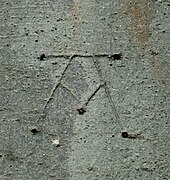 Mason's mark from Nidaros Cathedral, Trondheim, Norway, late 12th century
Mason's mark from Nidaros Cathedral, Trondheim, Norway, late 12th century -
 Masons's mark from Vår Frue Church, Trondheim, Norway, 12th century
Masons's mark from Vår Frue Church, Trondheim, Norway, 12th century -
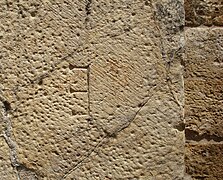 Mason's mark on exterior of Coimbra Cathedral, Portugal, 12th century
Mason's mark on exterior of Coimbra Cathedral, Portugal, 12th century -
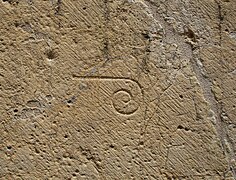 Mason's mark on exterior of Coimbra Cathedral, Portugal, 12th century
Mason's mark on exterior of Coimbra Cathedral, Portugal, 12th century -
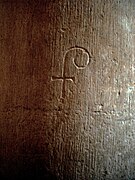 Mason's mark on interior column of Coimbra Cathedral, Portugal, 12th century
Mason's mark on interior column of Coimbra Cathedral, Portugal, 12th century -
![Mason's mark in the Église Saint-Honorat [fr] in Alyscamps, France, early 13th century](//upload.wikimedia.org/wikipedia/commons/thumb/3/36/Mason%27s_mark_St._Honorat_5.jpg/242px-Mason%27s_mark_St._Honorat_5.jpg) Mason's mark in the Église Saint-Honorat [fr] in Alyscamps, France, early 13th century
Mason's mark in the Église Saint-Honorat [fr] in Alyscamps, France, early 13th century -
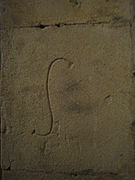 Mason's mark in the Église Saint-Honorat in Alyscamps France, early 13th century
Mason's mark in the Église Saint-Honorat in Alyscamps France, early 13th century -
 Arrowhead-shaped mason's mark in Athenry Priory, Ireland, 13th century
Arrowhead-shaped mason's mark in Athenry Priory, Ireland, 13th century -
 Mason's mark close to the Lintel at the Jagdschloss Grunewald, Germany
Mason's mark close to the Lintel at the Jagdschloss Grunewald, Germany -
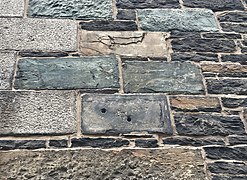 Mason's mark on Henry House in Halifax, Canada, from 1834
Mason's mark on Henry House in Halifax, Canada, from 1834 -
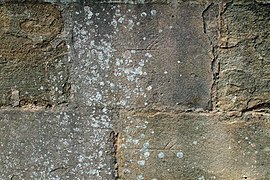 Mason's marks from Fountains Abbey, North Yorkshire, England
Mason's marks from Fountains Abbey, North Yorkshire, England -
 Mason's marks on the Canton Viaduct, Massachusetts, USA, 1834–1835
Mason's marks on the Canton Viaduct, Massachusetts, USA, 1834–1835 -
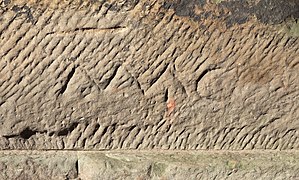 Roman mason's mark at the Porta Nigra in Trier, Germany
Roman mason's mark at the Porta Nigra in Trier, Germany -
 Horizontal Wolfsangel as a mason's mark, St Peter's Church, Walpole St Peter, Norfolk, England, 15th century
Horizontal Wolfsangel as a mason's mark, St Peter's Church, Walpole St Peter, Norfolk, England, 15th century
See also
- Benchmark (surveying)
- Builder's signature
- Carpenter's mark
- House mark
- Merchant's mark
References
- ^ a b c d Alexander, Jennifer (2006). "A History of Stonemasons' Marks and Stone Bonding Methods". In Prescott, Andrew (ed.). Marking Well: Essays on the Occasion of the 150th Anniversary of the Grand Lodge of Mark Master Masons of England and Wales and its Districts and Lodges Overseas. Hersham: Lewis Masonic. pp. 43–5. ISBN 0853182663.
Further reading
- Alexander, Jennifer S. (2007). "The introduction and use of masons' marks in Romanesque buildings in England". Medieval Archaeology. 51: 63–81. doi:10.1179/174581707x224660. S2CID 162218168.
- Brooks, Frederick William (1952). Masons' Marks. East Yorkshire Local History Series. Vol. 1. York: East Yorkshire History Society.
- Clegg, Robert Ingham (1921). "Masons' and Freemasons' Marks". Mackey's History of Freemasonry (2nd ed.). Chicago: The Masonic History Company.
- Davis, R. H. C. (1954). "A catalogue of masons' marks as an aid to architectural history". Journal of the British Archaeological Association. 3rd ser. 17: 43–76. doi:10.1080/00681288.1954.11894779.
- Tyson, Blake (1994). "Identifying and classifying masons' marks". Vernacular Architecture. 25: 4–15. doi:10.1179/vea.1994.25.1.4.
External links

Wikimedia Commons has media related to Stonecutter marks.
- Examples of Mason's marks
- Site detailing Mason's Marks in Scotland

Wikisource has the text of the 1911 Encyclopædia Britannica article "Banker-Marks".





![Mason's mark in the Église Saint-Honorat [fr] in Alyscamps, France, early 13th century](http://upload.wikimedia.org/wikipedia/commons/thumb/3/36/Mason%27s_mark_St._Honorat_5.jpg/242px-Mason%27s_mark_St._Honorat_5.jpg)
















